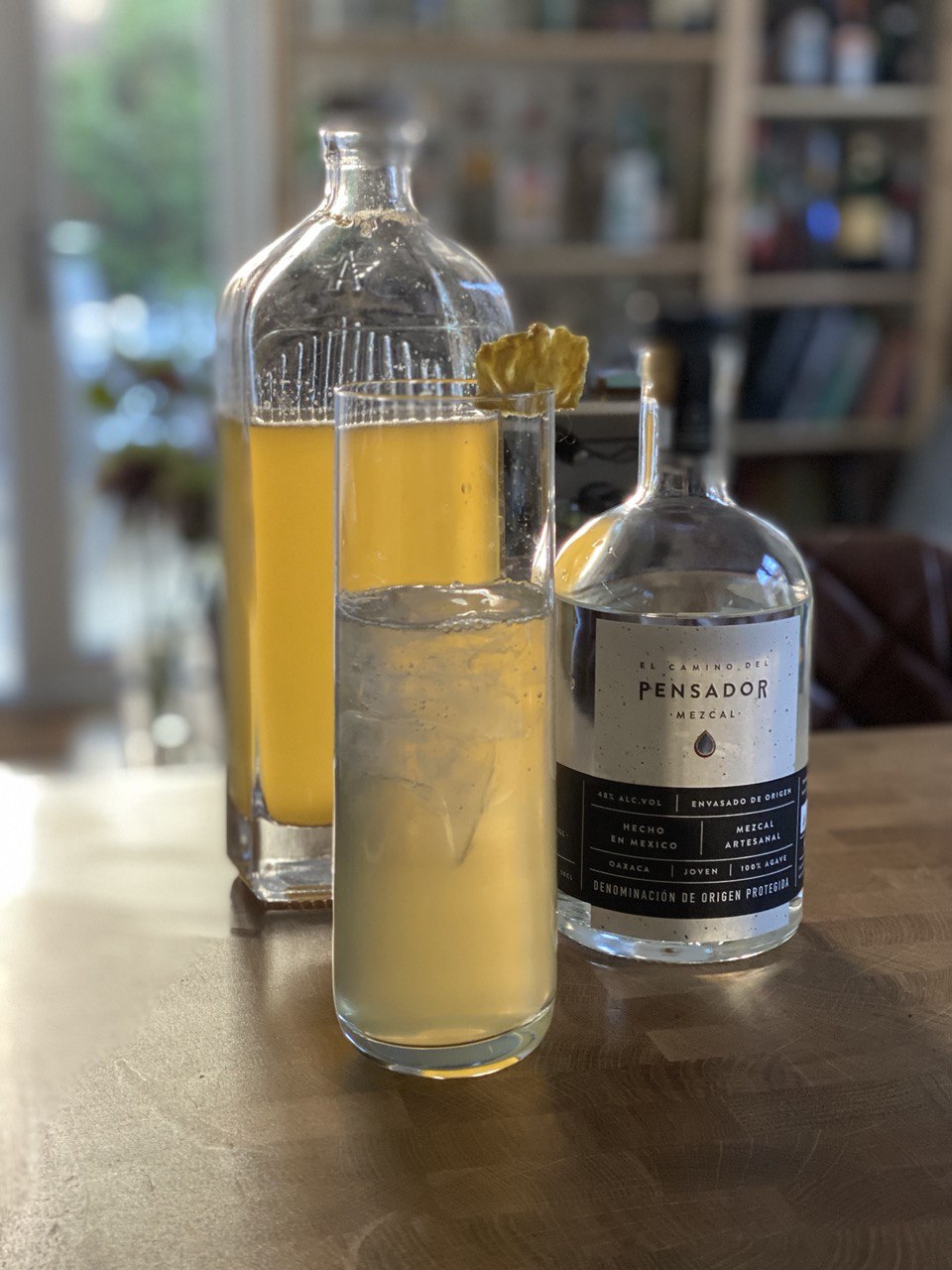Tuesday Triage #40
- TUESDAY TRIAGE #40 by Vadim Drobinin
- On Spring drinks
- Tepache Margarita
- Bloodless Mary
- Fermented parsnip
- Ely
- Things I enjoyed reading
- 1. Vegan Cheese, but Make It Delicious by Tejal Rao
- 2. Basic Music Theory in ~200 Lines of Python by Manohar Vanga
- 3. The road from Rome by @walterscheidel
- 4. How often do people actually copy and paste from Stack Overflow? Now we know by Ben Popper and David Gibson
- 5. How ‘Things’ In Fiction Shape the Way We Read by Sophie Haigney
- 6. The secret to successful BBQ pork butt and brisket is science by @JenLucPiquant
- 7. The Incredible Rise of North Korea’s Hacking Army by @edcaesar
- 8. In Defense of the Present Tense by @alexanderchee
- 9. How to Write a Technical Book by @serhack_
- 10. Spring in the Middle Ages by Lucie Laumonier
- Things I didn't know last Tuesday
- 1. Paternoster lift
- 2. London Pizza
- 3. Tichborne Dole
- 4. Victorian flirt
- 5. Cows officially the most deadly large animals in Britain
- 6. The Bisley Boy
- 7. Cheese in China
- 8. Wormwood was sometimes used instead of hops in beer
- 9. Beverly Hills ethymology
- 10. Ama
- Book of the week
- Thank you and see you in a week!
TUESDAY TRIAGE #40
by Vadim Drobinin ¶
Your weekly crème de la crème of the Internet is here!
20.04.2021 (read in browser)
On Spring drinks ¶
Last weekend I was celebrating a yet another turn around the Sun with the Napoleon cake Sasha baked for me:

It is made of very thin and flaky puff pastry layers, and has some smooth pastry cream in between them.
A taste of childhood.
And while I already touched the base on accumulating legacy, there is another way to look at accomplishments.
To me one of the highlights of the past year was a better understanding of the science behind food, which was gradually picked up over numerous dishes cooked, and then dozens of books read, and hundreds of articles questioned.
In my mind, a good sign that one is on the right path is being capable of cooking without a recipe constraints, and yet delivering something complex enough to unleash both techniques and creative power.
I had a chance to put those to test with a few most recent drinks of mine.
Tepache Margarita ¶
I've mentioned a fermentation experiment recently, which involved fermenting pineapple leftovers into an old Mexican drink with low ABV.
It worked out quite well, so I strained it through a few coffee filters to get rid of excess of yeast and mixed with some mezcal and seltzer to create an odd riff on both Margarita (tepache has a similar acidity thanks to fermentation) and Aperol Spritz (as it is naturally carbonated and sweet, and the taste profile is more complex after a week of fermenting):

Bloodless Mary ¶
This was my second attempt at clarifying tomato juice, and so far the most successful.
I got it paired with some spices, vinegar, Rye vodka, and then served on the rocks with a garnish of cherry tomatoes and pickled jalapeños in the glass, and a taralli with horseradish cream and pickled mustard on top.

I appreciate that minimalistic is the new black, but people drink Bloody Mary because of its garnishes, not because they like vodka and tomatoes.
Fermented parsnip ¶
Another example of just being smart about cooking (i.e not afraid to throw random things into common dishes) is this wood-oven pizza:

I lactofermented some parsnip with 2% of salt for a week, and while it lost pretty much all of its sweetness, it got a cleaner crunch and subtle complexity. Went great on a pizza with white sauce and forest mushrooms.
Looking forward to the next turn (also struggling to choose between a rotovap and a centrifuge as a belated birthday gift to myself).
Ely ¶
On a completely separate note, I do my best to leave the city for birthdays, and this year we went to Ely, Cambridgeshire, which is a city in the middle of nowhere, and is used to be called Isle of Ely (or "island of eels").
It sounds unexpected today, but four hundred years ago it was surrounded by water, and they were famous for eels.
These days there is an annual eel-throwing festival, but only with plastic ones instead.
Also there is a beautiful cathedral:

And we have visited our first pub in half a year. Bangers and mash are as good as in 2020.

That's pretty much the only dish I don't bother making at home: takes too much time and never gets as good as in a free house.
Maybe one day...
Things I enjoyed reading ¶
1. Vegan Cheese, but Make It Delicious by Tejal Rao ¶
The title is misleading, as it is less about vegans and more about a new way of applying classic techniques to unexpected ingredients.
Their Chebrie is harder to categorize. It’s marketed as a Cheddar-Brie hybrid, which would, I think, be a little monstrous if it were made of milk. Cut into the healthy, fuzzy white rind, and it reveals a baby-food orange interior that’s sharp and creamy, holding its shape but just soft enough to spread. It’s delicious.
When I sliced the Chebrie to taste with some crackers, along with a glass of cold, bubbly wine, I found that the language of dairy, the universe of familiar cheeses I knew, wasn’t enough. I needed new words, new categories, new reference points.
Sadly, calling the approach "vegan" actually limits the opportunities as for example one has to use agar, not gelatin, even if they'd want to. Any way, it's a really interesting experiment and I am looking forward to trying it out.
2. Basic Music Theory in ~200 Lines of Python by Manohar Vanga ¶
Such a nice way to explain basics of music theory through writing code.
The key thing to remember on why we need these equivalents is that, when we start to derive common scales (major, minor and the modes), consecutive notes must start with consecutive letters. Having enharmonic equivalents with different alphabets allows us to derive these scales correctly.
As someone who used to know but completely forgot almost everything about the music theory, this is probably one of the easiest ways to refresh the knowledge.
3. The road from Rome by @walterscheidel ¶
An unusual way to look at the fall of the Roman Empire: the author argues that Romans were so powerful they could eventually doom the humanity.
If an asteroid hadn’t knocked out the dinosaurs 66 million years ago, our tiny rodent-like ancestors would have had a hard time evolving into Homo sapiens. But even once we had gotten that far, our big brains weren’t quite enough to break out of our ancestral way of life: growing, herding and hunting food amid endemic poverty, illiteracy, incurable disease and premature death. It took a second lucky break to escape from all that, a booster shot that arrived a little more than 1,500 years ago: the fall of ancient Rome.
4. How often do people actually copy and paste from Stack Overflow? Now we know by Ben Popper and David Gibson ¶
I have a dedicated talk about lazy developers copying from StackOverflow, and now I can finally back it with numbers:
One out of every four users who visits a Stack Overflow question copies something within five minutes of hitting the page. That adds up to 40,623,987 copies across 7,305,042 posts and comments between March 26th and April 9th. People copy from answers about ten times as often as they do from questions and about 35 times as often as they do from comments. People copy from code blocks more than ten times as often as they do from the surrounding text, and surprisingly, we see more copies being made on questions without accepted answers than we do on questions which are accepted.
Such a shame they didn't know what exactly was copied (what if everyone just copies usernames to find folks on Twitter to say thank you?).
5. How ‘Things’ In Fiction Shape the Way We Read by Sophie Haigney ¶
Something I didn't think of before, but now it seems pretty obvious: the books we read to some extent work as monuments and anchors for objects of the past, or even their fiction counterparts.
It is instead, she writes, “a book about books about disappearing objects,” a literary study that explores the way objects’ disappearance and persistence has been represented on the page, especially in 20th century novels. Wasserman’s incisive book considers what fiction can tell us about living among things that are so frequently disposable, such that we “confront at every turn not so much the death of things, but their perpetual dying.
6. The secret to successful BBQ pork butt and brisket is science by @JenLucPiquant ¶
An almost detective story about finding the case of slowly cooked pork cooking too slow:
Blonder has been an avid, inventive cook ever since college, when the only tools he had to work with were a single hot plate and pot. When a friend once visited from Hawaii, they roasted a whole pig on hot rocks in the backyard. Ever the scientist, Blonder stuck a pair of thermocouples into the carcass to monitor the changing temperature as it cooked. So naturally, when he heard about the stall, he decided to test it experimentally.
Luckily these days one could just bag the pork with curing salts and liquid smoke into a sous vide bag, and then quickly grill it in the morning for the same result sans the hastle.
7. The Incredible Rise of North Korea’s Hacking Army by @edcaesar ¶
This is a hilarious (in a good sense) article, despite portraying ICPC (the programming competition) in a rather odd light:
North Korea’s cybercrime perpetrators often seem like faceless, amoral criminals. They also seem like victims. Costin-Andrei Oncescu, the Oxford programmer, was saddened to think of brilliant young North Korean minds being wasted in schemes to rob banks and install ransomware. But it is almost impossible to learn the stories of people from the program.
I wonder if my home country once will follow the same path though.
8. In Defense of the Present Tense by @alexanderchee ¶
As a non-native English speaker, I rarely think of tenses even though they used to be the only thing I cared about.
In literary criticism, when describing what a writer has done, the writer’s work is treated as a continual present—a place where everything is still happening each time it is read. This resembles the way victims of assault and trauma think of their memories—they almost always tell the story of what happened to them in the present tense, because it is a place still vivid for them, in their minds. It is entirely plausible to imagine any of these being an influence on a writer in search of form or texture.
Apparently the Present Tense is something to avoid, or so it seems at least. I quite like it though: it's cinematic, immediate, and at times feels way more authentic than anything else.
9. How to Write a Technical Book by @serhack_ ¶
Writing books is not an easy chore, and yet technical books exist in their own world, full of specific rules and templates.
Luckily, it's not always that bad:
Remember that you are not a professor, so ignore the idea of writing something like a university textbook. Getting a textbook adopted for a course is a rarity. For a textbook, most publishers will not engage with you unless you are a professor or a researcher with a PhD who is an expert in a specific field.
10. Spring in the Middle Ages by Lucie Laumonier ¶
I never though of that as a separate literary genre but there is a point:
The “reverdie,” or “re-greening” is a literary genre celebrating Spring and love that emerged in the courtly poetry of the High Middle Ages. Its stylistic conventions are vague but the reverdie is featured by its themes: Spring and love. Reverdies celebrated the months of April and May, they evoked the warmer light and delightful weather, the beauty of nature, its leaves and flowers, the sound of springs and bird songs. Even the opening verses of Chaucer’s Canterbury Tales borrow to the reverdie genre when they evoke the “sweet breath” of April’s winds, its “sweet” showers, the “tender shoots” and the “small fowls” singing their “melody”.
Now I have a good word to describe the Petrarchan sonnets.
Things I didn't know last Tuesday ¶
1. Paternoster lift ¶
I was aware of these lifts, but never knew neither how they are called, nor what are the origins of the name.
Needless to say, it's a bit unexpected:
The name paternoster ("Our Father", the first two words of the Lord's Prayer in Latin) was originally applied to the device because the elevator is in the form of a loop and is thus similar to rosary beads used as an aid in reciting prayers.

I wonder how often they break, and when they do, does it count as a fast track to Heaven due to their metaphysical value?
2. London Pizza ¶
Folks in Yorkshire eat something called London Pizza, which sounds rather disgusting, and probably are convinced that this is something very popular in the capital.
Teesside's pizza choices revealed some fairly unique preferences.
For example, the London pizza (a margherita with chips and garlic sauce on top) came fourth.
It was available from 97 shops - yet only 302 takeaways served this pizza nationally.
On a second thought, after a pie barm I am not really surprised anymore.
3. Tichborne Dole ¶
There is a British village with an annual festival where the priest gives away flour to locals, thanks to a somewhat grim history:
According to local tradition, Lady Tichborne's husband, Sir Roger Tichborne, did not approve of her charity and agreed to her bequest on the condition that the Dole consisted only of produce from land that she was able to encircle under her own power while carrying a burning torch in her hand. Lady Tichborne, who was in poor health, is said to have successfully crawled around a 23-acre (93,000 sq.m.) field before the torch went out, and this area became known as the Crawls.
Such a loving husband, I must say.
4. Victorian flirt ¶
The art of flirting back then was way more complex. They'd give each other cards like that (sometimes more intimate, but the idea would still be the same):

The most interesting is the way they'd use hidden gestures to communicate, like books, hand fansm, or surprisingly cigars:
CIGAR FLIRTATION
...
Blowing smoke straight, Are you engaged for the night
Rolling cigar between forefinger and thumb, Yes
Rolling in both hands, No
The problem is, there is no way to blow smoke without saying something.
Now live with this knowledge.
5. Cows officially the most deadly large animals in Britain ¶
I am not sure what is the cause of it: whether the Brits killed all wild animal bigger than a badger, or cows are actually the killing spray machines:
Walkers and farm workers who fall foul of the one-tonne animals are often crushed, butted or trampled to death, the review into cattle-related deaths found.
Anyway, these paths through farms are protected for a reason.
6. The Bisley Boy ¶
There is a conspirocy theory (apparently, a popular one!) about the real Queen Elisabeth I being killed in her childhood, so for the rest of her reign she was impersonated by a boy dressed like her.
When Bram Stoker visited Bisley in the late nineteenth century, he was intrigued by the village’s strange May Day tradition. Like most villages at the time, the village chose a May Queen every year. But in Bisley, the May Queen was always a young boy in an Elizabethan-style dress. When he asked why, villagers told him about the legend of the Bisley Boy. Bram went on to research the story extensively, and wrote about it in his 1910 book, Famous Imposters.
Read the whole legend, it has a plenty of realistic details.
7. Cheese in China ¶
I was always taught that there are no cheeses in China, and seems like it is quite far from being true:
Historically, however, there was cheese in China—even in the areas considered the cradle of the country’s civilization. Dairy was a regular part of China’s medieval diet, and cheese continued to be available across the country for centuries: A number of Chinese books from the 1500s include recipes for making cheese by adding acid to milk (rather than rennet) as well as cheese-centered recipes that range from stews to steamed dishes to pastries.
Surprisingly, it makes them closer to Russian творог (tvorog) and its Easter European relatives.
8. Wormwood was sometimes used instead of hops in beer ¶
Since we started to grow wormwood at home with a plan to use it for homemade vermouths, I was reading on potential things to look out for when gathering it myself (e.g what if stems are not edible?), and came across a plenty of other uses:
In the Middle Ages, wormwood was used to spice mead, and in Morocco it is used with tea, called sheeba.
Wormwood was traditionally relatively common as a bittering spice in farmhouse brewing in Denmark, and to some extent Estonia. In 18th century England, wormwood was sometimes used instead of hops in beer.
At least that's easy to make than absinthe.
9. Beverly Hills ethymology ¶
So hear me out.
Beverly Hills, California is named after Beverly Farms, Massachusetts.
Which is named after the town Beverley in Yorkshire, England.
Which came from the name "Beverlac" in the 10th century, meaning "beaver lake", thanks to beavers in a nearby river.
Originally, the town now known as Beverley was called Inderawuda, the name of a church founded there by the Bishop of York in 700 AD. In the 10th century, the townspeople changed its name to Beverlac, or beaver lake, because there was a large beaver population in the nearby River Hull. By 1037, the town was known as Beverley, and the Bishop of York who had founded the original church 300 years earlier was canonized as St. John of Beverley.
10. Ama ¶
There are some photos following the url, but the story behind this is quite fascinating too:
The term Ama (海女 in Japanese) literally means ‘women of the sea’, as women were always the preferred divers in Japan. Since ancient times Ama would free dive into the Pacific to retrieve seaweed, abalone, shellfish, and sometimes pearls, wearing nothing but a loincloth and goggles.
Book of the week ¶
One of my guilty pleasures is to roam through random charity shops and pick up books I'd never search for on purpose.
Not because I wouldn't want to pay more than a fraction of their price, but because I would never think to look out for them in the first place.
One of the most recent treasures I've found is Neil M. Gunn's Whisky & Scotland:
As for the hard secret drinker, he will experience the fear of certain burrowing forms of life for any sort of light. And even amongst those who drink openly and in defiance of kirk and banker, the uproarious rebels, the poets and navvies and novelists, there will be hearty encouragement to go full steam agead, to give it to old Calvin in the neck, to rock all canting hypocrisy to its rotten feet, to have an orgy and sing the roof off the inhibited camphor-smelling vacuum that is the respectable Scottish mind.
This is a great story of history, traditions, and the magic behind whisky's sacred distillation from the grain, as well as a good intro into Gaelic way of living.
Despite my love for whisky, especially Islay Scotch, I mostly mix it in cocktails, which is usually thrown upon by real connoisseurs, and I can't blame them. Most likely I just didn't come across something so expensive and so good that the only way to make it even better would be a drop of cold water.
In the meantime, scotch is a powerful ingredient to work with, and even a mere teaspoon floated on top of a whisky sour is more than enough to change its texture, flavour, and smell altogether.
Here is to the world where people are not afraid of unconventional combinations of spirits in their glasses.
Thank you and see you in a week! ¶
If you have any questions, or want to suggest a link for the next newsletter, please drop me a message on Twitter or reply to this email.
Cheers! 🍸